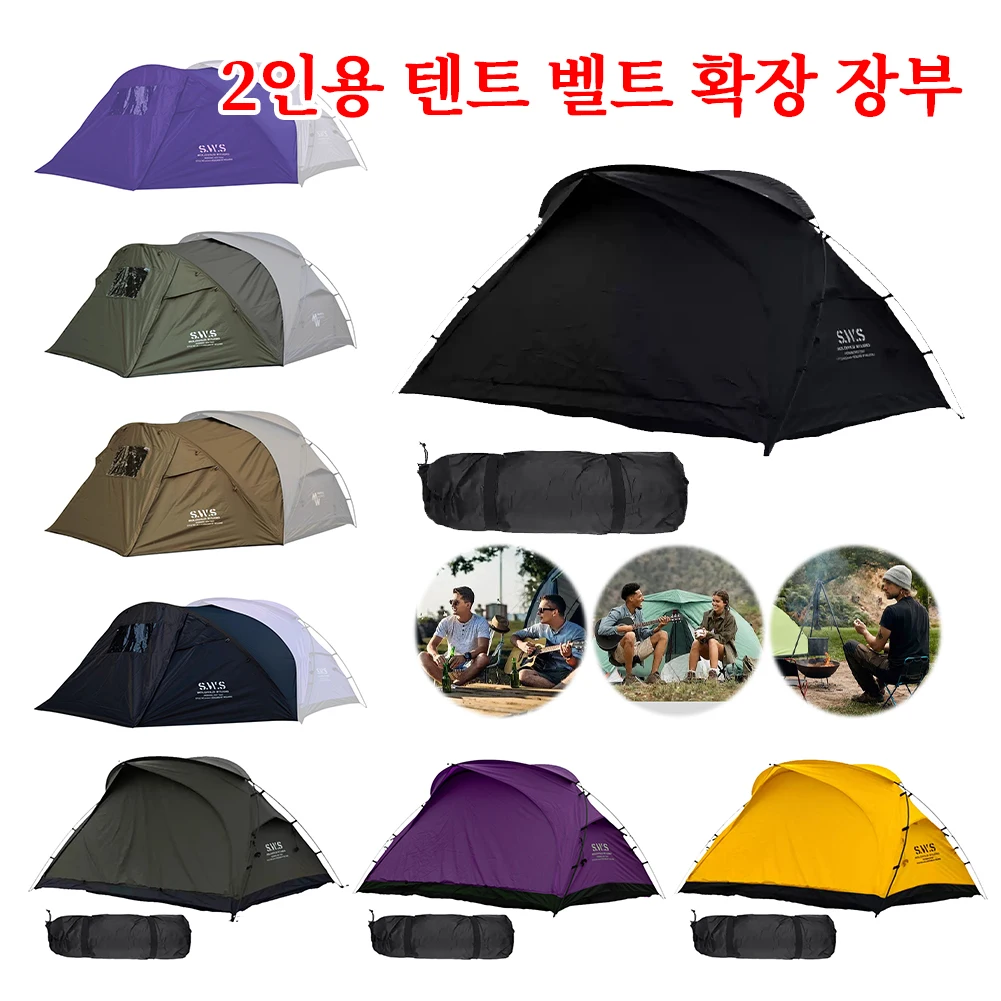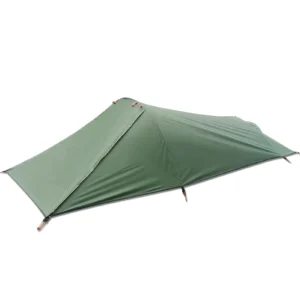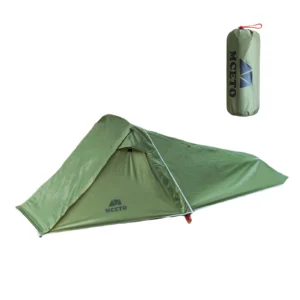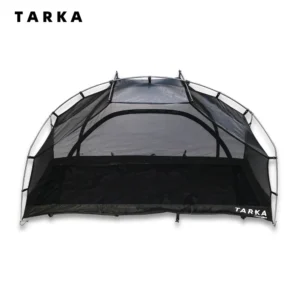Introduction
The growing popularity of trekking pole tents among lightweight backpackers is no coincidence. These innovative shelters eliminate the need for dedicated tent poles, saving 1-2 pounds (0.45-0.9 kg) compared to traditional freestanding tents—a significant weight reduction for those covering long distances on foot. However, this weight-saving design comes with a particular challenge: successfully setting up these non-freestanding shelters on uneven terrain.
For many backpackers, the ability to pitch a trekking pole tent on varied surfaces isn’t just convenient—it’s essential. When trails lead to remote alpine meadows, forested slopes, or rocky outcrops, finding perfectly flat ground becomes a luxury rather than an expectation. Understanding different shelter options for two campers becomes crucial when selecting gear for diverse terrain.
This guide provides practical techniques for achieving a stable, weather-resistant setup on challenging surfaces, expanding your campsite options and enhancing your backcountry experience. Whether you’re new to how trekking pole tents work or looking to refine your skills, these expert tips will help you master the art of pitching on uneven ground.
Understanding the Challenges of Trekking Pole Tents on Uneven Ground
Before addressing solutions, it’s important to understand why uneven terrain presents unique challenges for trekking pole tents. Unlike freestanding tent structure explained by traditional designs, trekking pole tents rely entirely on tension to maintain their shape and stability.
When pitched on uneven ground, several key issues emerge:
- Compromised tension distribution: Even a 5-degree slope can significantly affect pole perpendicularity, creating loose sections in the fabric while over-tensioning others.
- Unstable pole placement: On slopes, trekking poles tend to slip or lean, compromising the entire structure.
- Irregular interior space: Uneven pitching reduces usable space inside the tent, potentially making sleeping arrangements uncomfortable.
- Reduced weather resistance: Improperly tensioned fabric allows more movement in wind and can create areas where rain collects rather than sheds.
- Difficult door and vestibule function: When pitched on a slope, doors may not close properly, and vestibules may hang incorrectly.
The specific terrain challenges vary widely:
– Slopes affect the angle of poles and create sliding pressure
– Rocky areas prevent proper stake placement and create potential abrasion points
– Root-filled sites block ideal stake locations and create uneven floor surfaces
– Loose soil provides inadequate anchor points for stakes
Many ultralight trekking pole tent designs prioritize minimalism, which means fewer adjustment points to compensate for terrain irregularities. This makes proper setup technique all the more important.
Essential Pre-Trip Preparation for Success
Successful setup on challenging terrain begins long before you reach the backcountry. Proper preparation ensures you’ll have the necessary tools and knowledge when facing difficult pitching conditions.
Know Your Tent’s Design
- Study your tent’s recommended pole heights and minimum/maximum adjustment ranges
- Identify all guyout points, including optional ones not required for basic setup
- Understand which tension points are most critical for structural integrity
- Practice adjusting pole heights to create balanced tension across the canopy
Assemble a Versatile Stake Kit
Different terrain demands different anchoring solutions. A well-prepared backpacker carries a variety of stakes:
- 4-6 primary stakes suitable for most conditions
- 2-3 specialized stakes for problematic ground (snow/sand stakes, nail-style for hard soil)
- 2-3 extra stakes in case of loss or for additional guylines
Many backpackers experienced with mastering two-person lightweight tent setup recommend bringing at least two extra stakes beyond the minimum requirement.
Essential Additional Items
- 2-3 extra 6-foot (1.8 m) guylines with tensioners
- Small repair kit (fabric patches, pole repair sleeve)
- Small stuff sack for rocks (useful for creating anchors)
- Ground protection (footprint or groundsheet) for rocky or rough surfaces
Practice Before Your Trip
Set up your tent on various surfaces near home before heading into the backcountry. This builds muscle memory for the techniques we’ll cover and helps identify any special requirements of your specific tent model.
Stake Selection for Various Terrain Types
| Terrain Type | Recommended Stake Type | Key Benefits |
|---|---|---|
| Standard soil | Y-stakes or V-stakes | Excellent all-around holding power, moderate weight |
| Hard/rocky ground | Nail-style stakes | Better penetration, less bending |
| Soft/sandy soil | Wide profile stakes or snow stakes | Greater surface area prevents pulling out |
| Forest floor | Shepherd’s hook stakes | Easier to work around roots, simple to remove |
When selecting stakes for your trekking pole backpacking tent, prioritize versatility while keeping weight reasonable. A combination of Y-stakes for primary anchoring and a few specialized stakes for challenging conditions offers the best balance.
Trekking Pole Considerations and Adaptations
The poles themselves are critical components in your shelter system. Consider these factors:
- Adjustability: Poles with fine adjustment increments (ideally 0.5 inch/1 cm) provide better setup precision
- Locking mechanism: Choose poles with secure locks that won’t slip under tension
- Tip protection: Carry small pieces of durable fabric to place under pole tips on solid rock to prevent slipping
- Alternative configurations: Learn how your tent can be pitched with alternative pole placements (crossed poles, shortened heights) for extreme conditions
For backpackers interested in compatible trekking poles tents, consider how pole features specifically enhance tent setup capability rather than just hiking performance.
Strategic Campsite Selection for Trekking Pole Tents
Even with perfect technique, some spots simply work better than others. Developing an eye for good tent sites is a valuable skill.
Site Assessment Checklist
- Slope gradient: Use a trekking pole laid horizontally as a basic level to assess the slope. Minimal slope is ideal, but consistent slope is better than irregular ground.
- Slope direction: Note the direction of the slope relative to the wind. When possible, orient your tent with the narrowest profile facing upwind.
- Surface composition: Examine what’s beneath the surface vegetation. Areas with small pebbles may be more stable than those with hidden larger rocks.
- Natural anchoring options: Look for small trees, sturdy shrubs, or immovable rocks that could serve as anchor points.
- Water drainage: Avoid depressions where water might channel or collect, even if they appear level.
- Overhead hazards: Check for dead branches or unstable rocks above your potential site.
Spending an extra 5-10 minutes finding the best possible location can save hours of frustration during setup and ensure a more comfortable night’s sleep. This becomes particularly important with waterproof backpacking tent designs where proper pitch affects weather protection.
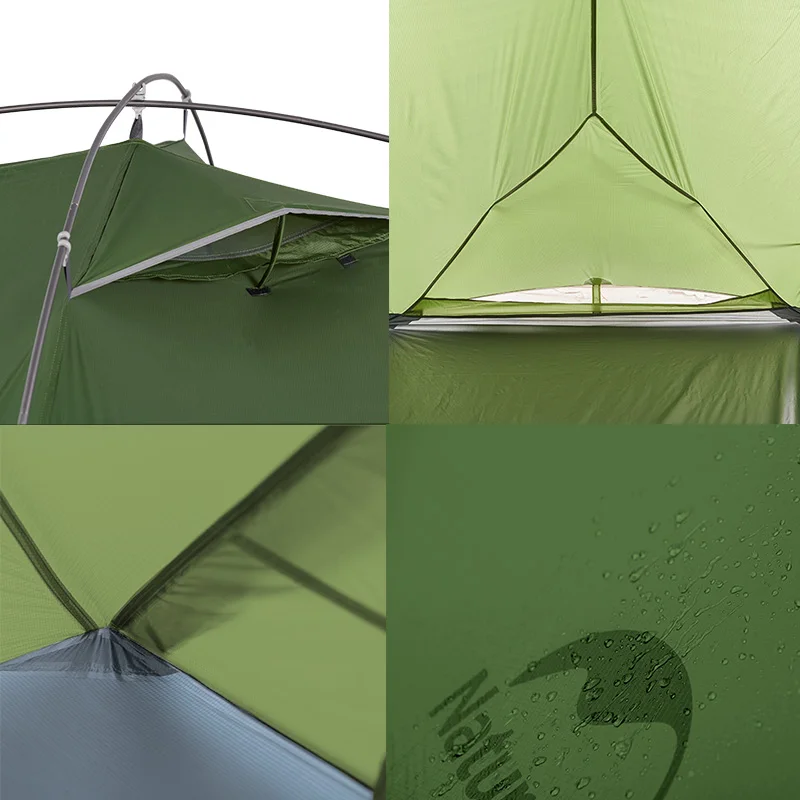
Core Techniques for Pitching on Slopes and Uneven Ground
With preparation complete and a site selected, these step-by-step techniques will help you achieve a stable pitch on challenging terrain.
Orient the tent properly: Position the tent with the door away from the slope when possible, or perpendicular to the slope for easier entry and exit.
Create a baseline: Establish your first anchor point at the highest point of the slope, then the second anchor at either the same elevation across the tent or at the lowest point.
Adjust pole heights before inserting: For a slope running from head to foot of the tent, make the downhill pole 2-4 inches (5-10 cm) taller than the uphill pole to create a level ridgeline.
Insert poles and create initial tension: Place poles at their adjusted heights and secure the central guylines to create basic structure.
Stake out corners in a specific sequence: Begin with the highest corner, then the opposite corner, adjusting tension as you go. This creates the foundation for the remaining stakes.
Add midpoint stakes: Once the corners are secure, add midpoint stakes, working from highest to lowest points.
Fine-tune the entire structure: Make small adjustments to pole heights, guyline tension, and stake positions until the fabric shows even tension throughout.
For those learning how to set up trekking pole tent basics, master flat-ground setup before attempting these advanced techniques.
Pole Height Adjustment Principles
Proper pole height adjustment is the foundation of successfully adapting to uneven ground:
- For every 5 degrees of slope, adjust pole heights by approximately 1-2 inches (2.5-5 cm) between uphill and downhill sides
- Maintain perpendicularity to the ground rather than absolute vertical orientation
- For side-sloping ground, adjust the pole on the higher side to be shorter
- When in doubt, slightly overtension the ridgeline rather than leaving it loose
The goal is to create a consistent plane for the tent body regardless of what’s happening with the ground beneath it. This principle applies to various lightweight backpacking tent designs, though the specific adjustments will vary by model.
Mastering Guyline Tension for Maximum Stability
Follow this tensioning sequence for optimal stability:
- Start with ridgeline/main support guylines at 45-degree angles from the tent
- Tension opposing sides in pairs to maintain balance
- Apply slightly more tension to uphill guylines to counteract downward force
- Use line tensioners to make micro-adjustments without moving stakes
- Check tension by lightly pressing on the fabric—it should feel drum-tight but not strained
Remember that fabric stretches throughout the night as humidity changes, so start with slightly higher tension than you think necessary, particularly with silnylon tents.
Advanced Anchoring Solutions for Challenging Terrain
When traditional staking isn’t possible, these creative solutions keep your backpacking tent vestibule and main body secure.
Rock Anchoring Techniques
When faced with rocky ground where stakes won’t penetrate:
Direct Tie-off Method
1. Find a rock weighing at least 5-10 pounds (2.3-4.5 kg)
2. Create a loop in your guyline and place it under the rock
3. Position the rock so the pull direction keeps the line under tension
4. For critical anchor points, use larger rocks or stack multiple rocks
Deadman Rock Anchors (for loose soil or snow)
1. Dig a small trench perpendicular to the pull direction
2. Place a flat rock in the trench with the guyline wrapped around it
3. Bury the rock and compact the soil on top
4. This creates an extremely strong anchor point for critical guylines
Crevice Wedging
1. Find a crack between immovable rocks
2. Wrap your guyline around a small rock or stick
3. Wedge this rock firmly into the crevice
4. Test by pulling firmly before relying on it
To prevent cord abrasion on rough rocks, use small fabric patches between the rock and guyline, or carry a few feet of thicker accessory cord specifically for rock anchoring.
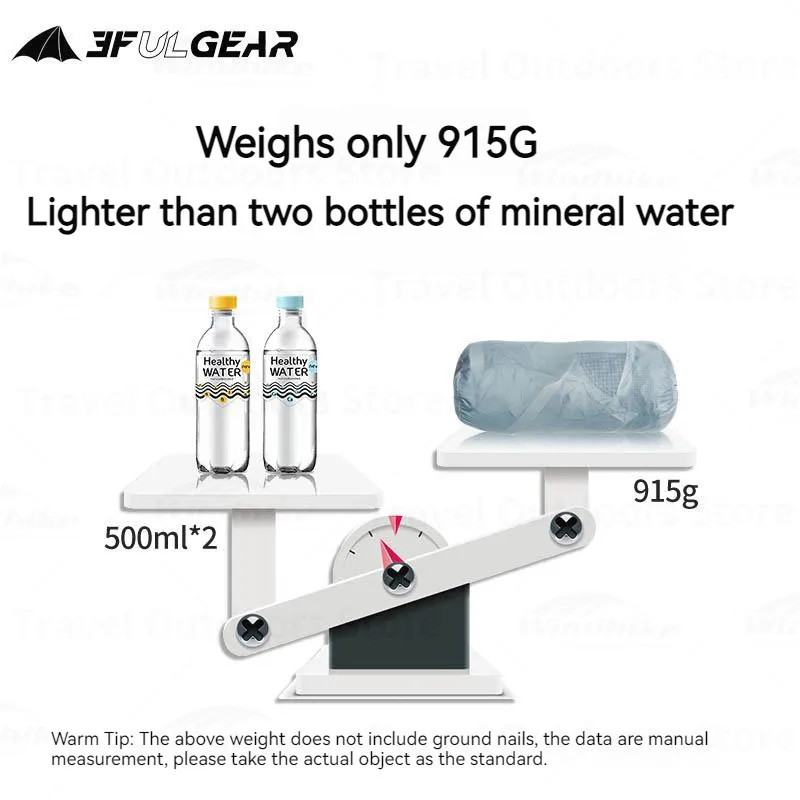
Fine-Tuning for Weather Resistance and Comfort
Once your tent is pitched, these refinements ensure it stays secure and comfortable:
- Eliminate fabric sag: Look for any loose sections and adjust the nearest guyline or stake
- Create proper ventilation: Position door openings to capture breezes while maintaining protection
- Anticipate overnight changes: Slightly overtension fabric if expecting temperature drops or rain
- Check ground clearance: Ensure adequate airflow under the rainfly to minimize condensation
- Secure loose components: Tuck away any flapping fabric edges or loose straps
Mastering these adjustments makes choosing ultimate compact shelter for two campers much more successful, as you’ll be able to optimize any shelter design for various conditions.
Maximizing Interior Comfort on Sloped Ground
Even with a perfectly pitched tent, sleeping on a slope requires adaptation:
- Orient your sleeping position with your head uphill whenever possible
- Create a sleeping platform using spare clothing under your sleeping pad at the downhill side
- Use backpack as a stopper at the foot of your sleeping pad to prevent sliding
- Position gear strategically along tent edges to expand the flat sleeping area
- Consider a diagonal sleeping position in some tent designs to find the flattest plane
These techniques are particularly valuable in 2-person backpacking tents where managing interior space efficiently becomes even more important.
Lightweight Backpacking Tent, Ultralight Backpacking Tent, Ultralight Bivy Tent
Ultralight Single Person Camping Tent with Aluminum Poles for 3-Season Backpacking Waterproof DesignPrice range: $94.88 through $326.82 Select options This product has multiple variants. The options may be chosen on the product pageLightweight Backpacking Tent, Ultralight Backpacking Tent, Waterproof Backpacking Tent
$391.05 Select options This product has multiple variants. The options may be chosen on the product pageCompact Backpacking Tent, Lightweight Backpacking Tent, Waterproof Camping Tent
$335.52 Select options This product has multiple variants. The options may be chosen on the product pageBackpacking Tent with Vestibule, Freestanding Backpacking Tent, Lightweight Backpacking Tent
Price range: $446.89 through $447.22 Select options This product has multiple variants. The options may be chosen on the product pageBackpacking Tent with Vestibule, Trekking Pole Backpacking Tent, Waterproof Camping Tent
Price range: $271.99 through $519.52 Select options This product has multiple variants. The options may be chosen on the product pageUltralight Backpacking Tent, Ultralight Trekking Pole Tent
Price range: $350.87 through $351.98 Select options This product has multiple variants. The options may be chosen on the product page
Troubleshooting Common Problems
Even experienced campers encounter challenges. Here are solutions to common issues:
Slipping Pole Tips on Hard Surfaces
– Place pole tips on small pieces of high-friction material (silicone, rubber)
– Create small depressions in the ground for pole tips
– Use rocks to create stable platforms for pole placement
Persistent Fabric Sag
– Readjust the entire tension system, starting from the main support points
– Add additional guyout points if your tent has attachment points for them
– Check for water pooling that might be adding weight
Unstable in Changing Conditions
– Add crossing guylines to increase lateral stability
– Lower the overall tent profile in high winds
– Relocate to more protected terrain if conditions worsen significantly
Fabric Damage from Rough Ground
– Use a ground cloth or footprint under the entire tent
– Place small, soft items under pressure points where fabric contacts sharp objects
– Consider moving the tent if the terrain proves too abrasive
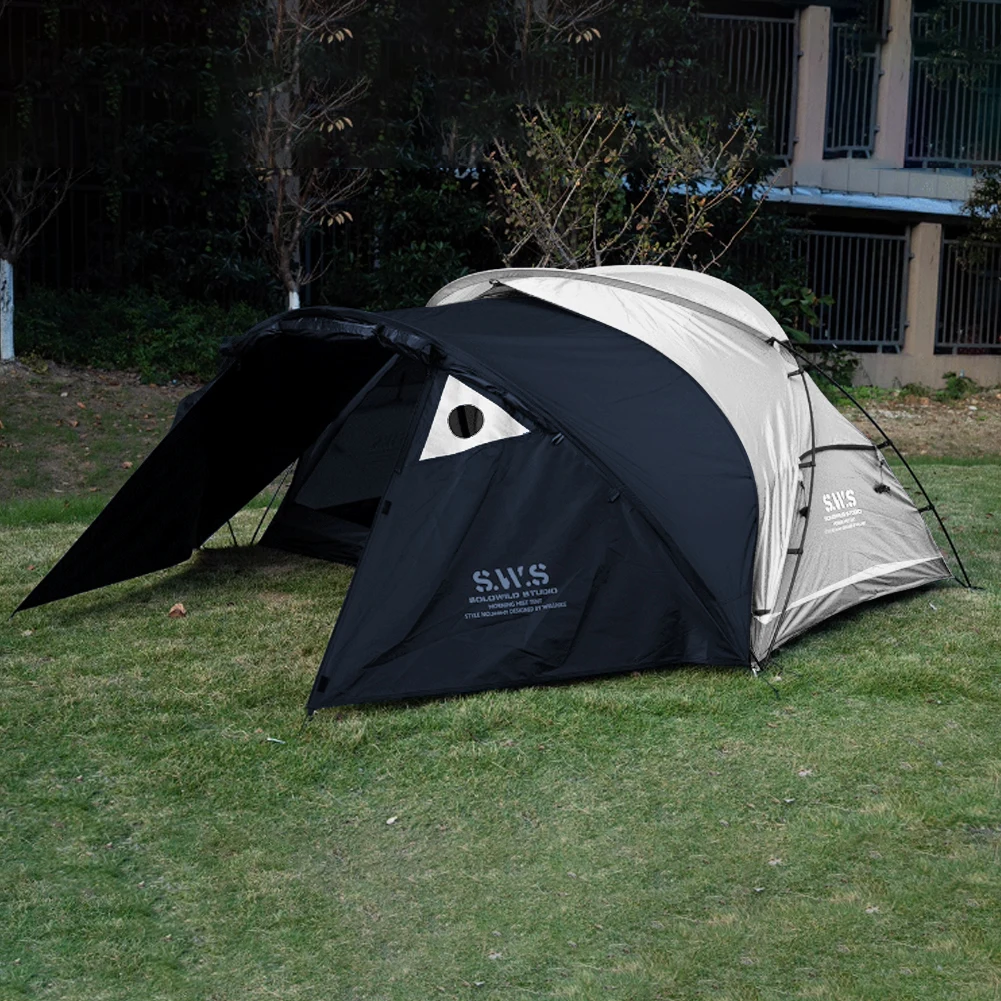
Leave No Trace Considerations for Uneven Terrain Camping
Pitching tents on challenging terrain shouldn’t come at environmental cost:
- Avoid moving large rocks that may host delicate ecosystems
- If you must clear small sticks or pine cones, scatter them back when breaking camp
- Use existing tent spots when possible rather than creating new impact areas
- Never cut or break vegetation to improve your site
- Fill in any small depressions created for tent stakes or poles
- Carry alternative anchoring gear (rock sacks) to reduce the need for moving natural materials
These practices ensure that others can enjoy these remote areas and that fragile alpine and forest ecosystems remain healthy.
Conclusion: Embracing the Freedom of Versatile Pitching Skills
Mastering trekking pole tent setup on uneven terrain transforms challenging campsites into opportunities. With the techniques covered—strategic site selection, proper pole adjustment, creative anchoring, and interior organization—you’ll approach your next backpacking trip with newfound confidence.
These skills not only expand your camping options but also allow you to select less-impacted sites away from heavily used areas, enhancing both your experience and environmental stewardship. The ability to comfortably camp on varied terrain opens up spectacular locations that many campers avoid—alpine ridges with sweeping views, forest clearings amid towering trees, and secluded stream banks.
Practice these techniques close to home before relying on them in remote areas. With experience, what once seemed like advanced skills will become second nature, allowing you to focus on enjoying the wilderness rather than struggling with your shelter.
Can You Use Any Trekking Pole Tent on Extremely Uneven Ground?
While proper technique can overcome many challenges, some tent designs adapt better to uneven terrain than others:
- Pyramid and mid-style tents generally offer the most adaptability due to their simple geometry and multiple adjustment points
- Tents with adjustable ridgelines provide more flexibility than those with fixed dimensions
- Designs with additional guyout points allow for customized tensioning on irregular surfaces
- Double-wall tents often require more precise setup than single-wall designs
The practical limits depend on both design and conditions:
– Slopes exceeding 15 degrees become challenging for any design
– Very rocky terrain may require specialized anchoring regardless of tent model
– Extremely uneven surfaces may create unavoidable interior comfort issues
For the most challenging conditions, compact backpacking tent options with simplified geometries often perform better than complex designs.
What Additional Skills Complement Uneven Terrain Pitching?
Several related skills enhance your ability to successfully camp on difficult terrain:
Basic Weather Reading
– Recognizing signs of approaching storms
– Understanding local wind patterns and how terrain affects them
– Identifying safe versus exposed locations
Essential Knots
– Taut-line hitch: creates adjustable tension on guylines
– Trucker’s hitch: provides mechanical advantage for tight guylines
– Clove hitch: secures lines to natural anchors like trees or rocks
Improvisation Techniques
– Using trekking poles in non-standard configurations
– Creating makeshift stakes from natural materials
– Fashioning emergency repairs for damaged components
These complementary skills make you more adaptable when conditions aren’t ideal, turning potential camping disasters into manageable situations.
Summary of Key Equipment for Successful Uneven Terrain Camping
This checklist covers the essential gear mentioned throughout this guide:
- Versatile stake kit: combination of Y-stakes, nail stakes, and snow/sand stakes (1-2 oz/28-56 g each)
- Extra guyline: 15-20 feet (4.5-6 m) of 1.5mm reflective cord (0.5 oz/14 g)
- Line tensioners: 4-6 lightweight adjusters (0.1 oz/3 g each)
- Small stuff sack: for rock anchoring (0.2 oz/6 g)
- Groundsheet: sized for your tent footprint (2-4 oz/57-113 g)
- Repair materials: patches, needle and thread, pole repair sleeve (1 oz/28 g)
The entire supplemental kit adds only 4-8 ounces (113-227 g) to your pack weight while dramatically improving your ability to create a stable shelter in challenging conditions.
By mastering these techniques and carrying the right equipment, you’ll transform what many consider a camping liability—uneven ground—into an asset that opens up new possibilities for backcountry exploration and solitude.

